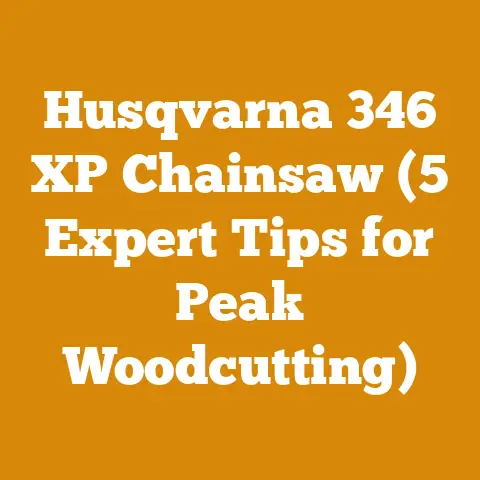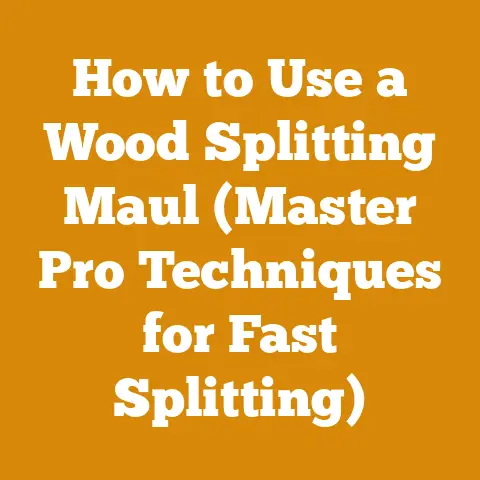How to Get Rid of Bradford Pear Trees (5 Proven Woodcutting Tips)
I remember the first time I saw a Bradford pear tree in full bloom. It was spring, and the neighborhood was awash in white blossoms. They were beautiful, undeniably so. But as the years passed, I started to understand the darker side of these seemingly innocent trees. Their weak branch structure meant they were prone to splitting in storms, and their invasive nature choked out native species. Now, as a seasoned woodworker and someone who values the health of our local ecosystems, I approach Bradford pears with a different perspective. I see them as a problem to be solved, a resource to be managed, and an opportunity to restore balance. And that’s where this guide comes in. I’m going to share my proven woodcutting tips to safely and effectively remove Bradford pear trees, turning a nuisance into a learning experience and, perhaps, even a source of usable wood.
How to Get Rid of Bradford Pear Trees (5 Proven Woodcutting Tips)
Bradford pear trees, while visually appealing in the spring, are notorious for their weak wood, invasive tendencies, and short lifespans. Removing them requires a strategic approach, combining proper cutting techniques with an understanding of tree biology and safety. I’ve spent years refining my methods, and in this guide, I’ll share the five most effective woodcutting tips I’ve learned.
1. Understanding the Enemy: Bradford Pear Biology and Identification
Before I even think about picking up a chainsaw, I take the time to understand what I’m dealing with. Bradford pears ( Pyrus calleryana ‘Bradford’) are cultivars of the Callery pear, a tree native to Asia. They were initially prized for their ornamental qualities, but their widespread use has led to significant ecological problems.
- Weak Wood Structure: The tightly clustered branch angles create weak points prone to breakage, especially in wind and ice. This is probably the biggest reason you’re looking to get rid of them.
- Invasive Nature: Bradford pears readily escape cultivation, outcompeting native plants and disrupting ecosystems. Their prolific seed production, spread by birds, contributes to this.
- Short Lifespan: These trees typically live only 15-25 years, making their presence in your yard a temporary, albeit problematic, one.
- Identification: Look for a medium-sized tree (30-50 feet tall) with a rounded or oval crown. In spring, they’re covered in dense clusters of white flowers with a distinct, sometimes unpleasant, odor. The leaves are simple, oval-shaped, and glossy green. In the fall, they turn reddish-purple.
Personal Story: I once had a Bradford pear in my backyard that dropped a massive branch during a relatively mild thunderstorm. It narrowly missed my car and caused significant damage to my fence. That incident solidified my understanding of the inherent dangers posed by these trees.
2. Safety First: Essential Gear and Precautions
Woodcutting is inherently dangerous, and safety should always be your top priority. I never compromise on safety gear or proper technique.
-
Personal Protective Equipment (PPE):
- Helmet: A properly fitted helmet is crucial to protect your head from falling branches or kickback.
- Eye Protection: Safety glasses or a face shield will shield your eyes from flying wood chips and debris.
- Hearing Protection: Chainsaws are loud! Earplugs or earmuffs will prevent hearing damage. I prefer earmuffs because they are easier to take on and off when communicating with others.
- Gloves: Sturdy work gloves provide a better grip and protect your hands from cuts and abrasions.
- Chaps: Chainsaw chaps are essential for leg protection. They’re made of ballistic nylon that will jam the chain in case of accidental contact. I’ve tested mine accidentally (thankfully not seriously) and can attest to their effectiveness.
- Boots: Steel-toed work boots with good ankle support are a must.
-
Chainsaw Inspection: Before each use, I thoroughly inspect my chainsaw.
- Chain Sharpness: A sharp chain is safer and more efficient. Dull chains require more force and are more likely to kick back. I sharpen my chain after every tank of gas or when I notice it’s not cutting as smoothly.
- Chain Tension: Proper chain tension is essential for smooth operation and to prevent the chain from derailing.
- Bar Lubrication: Make sure the bar oil reservoir is full and the oiler is functioning correctly.
- Throttle and Safety Mechanisms: Test the throttle trigger, chain brake, and other safety features to ensure they’re working properly.
-
Work Area Assessment:
- Clearance: Ensure you have a clear work area, free from obstacles and tripping hazards.
- Overhead Hazards: Check for overhead power lines, branches, or other potential hazards.
- Escape Route: Plan a clear escape route in case the tree falls in an unexpected direction.
-
Weather Conditions: Avoid cutting trees in high winds or during storms. Wet conditions can also make the ground slippery and increase the risk of accidents.
-
Never Work Alone: Always have someone nearby who can assist you in case of an emergency.
Data Point: According to the Occupational Safety and Health Administration (OSHA), most chainsaw accidents occur due to improper training, lack of PPE, and unsafe work practices. Taking the time to prepare and follow safety guidelines can significantly reduce your risk of injury.
3. Felling Techniques: Strategic Cuts for Controlled Tree Removal
Felling a tree safely and effectively requires understanding basic cutting techniques. I always aim for a controlled fall to minimize the risk of damage to property or injury.
-
The Notch: The notch determines the direction of the fall. It should be cut on the side of the tree you want it to fall towards.
- Open Face Notch: This is the most common type of notch. It consists of a horizontal cut that extends about one-third of the tree’s diameter, followed by an angled cut that meets the horizontal cut. The angle should be about 45 degrees.
- Humboldt Notch: This notch is similar to the open face notch, but the angled cut is made from the bottom up. It’s often used for larger trees.
- Kerf Width: The kerf is the width of the chainsaw cut. When making the notch, ensure the kerf is wide enough to allow the tree to fall freely.
-
The Back Cut: The back cut is made on the opposite side of the notch, slightly above the horizontal cut. It should be made carefully, leaving a hinge of wood to control the fall.
- Hinge Width: The hinge should be about 10% of the tree’s diameter. It acts as a guide, preventing the tree from twisting or falling in an uncontrolled manner.
- Holding Wood: Avoid cutting completely through the tree. Leave a small amount of holding wood to prevent the tree from falling prematurely.
-
Felling Wedges: Felling wedges are used to help direct the fall of the tree, especially if it’s leaning in the wrong direction. They are inserted into the back cut to push the tree over.
- Material: Wedges are typically made of plastic or aluminum. Never use steel wedges, as they can damage your chainsaw if you accidentally hit them.
- Placement: Insert the wedges into the back cut after making the initial cut. Use a hammer or mallet to drive them in further, gradually increasing the pressure on the tree.
-
Push Poles: Push poles can be used to help guide the tree’s fall. They are long, sturdy poles that are used to push the tree from the side.
Case Study: I once had to remove a Bradford pear tree that was leaning precariously towards my neighbor’s house. The traditional felling techniques wouldn’t work because of the risk of the tree falling in the wrong direction. I used a combination of felling wedges and a come-along (a hand-operated winch) to slowly and safely pull the tree in the desired direction. It took several hours, but the result was a controlled fall with no damage to property.
Tool Specifications:
- Chainsaw: I typically use a 20-inch chainsaw for felling Bradford pear trees. A chainsaw with a bar length that is slightly longer than the diameter of the tree is ideal. Stihl and Husqvarna are two reputable brands. I personally prefer Stihl for their reliability and ease of maintenance.
- Felling Wedges: I use a set of plastic felling wedges in various sizes. A 5.5-inch wedge is a good starting point.
- Axe: An axe is useful for limbing and splitting small branches. A 3.5-pound axe is a good all-around size.
4. Limbing and Bucking: Processing the Fallen Tree
Once the tree is on the ground, the next step is to limb and buck it. Limbing involves removing the branches, while bucking involves cutting the trunk into manageable lengths.
-
Limbing:
- Safety: Always stand on the uphill side of the tree when limbing. This prevents the tree from rolling downhill and potentially injuring you.
- Technique: Use the chainsaw to cut the branches close to the trunk. Be careful to avoid kickback.
- Pruning Saw: A pruning saw can be useful for removing smaller branches.
-
Bucking:
- Log Length: Determine the desired log length based on your intended use. Firewood is typically cut into 16-inch lengths, while lumber can be cut into longer lengths.
- Support: Support the log to prevent it from pinching the chainsaw blade. Use smaller logs or wedges to prop up the trunk.
- Cutting Technique: Make the cuts perpendicular to the trunk. Avoid cutting into the ground.
Unique Insight: Bradford pear wood is not particularly valuable for woodworking or firewood due to its weak structure and tendency to warp. However, it can be used for small projects like carving or turning on a lathe. It also burns reasonably well, although it doesn’t produce as much heat as hardwoods like oak or maple.
5. Stump Removal: Eradicating the Source of Regrowth
Leaving the stump in the ground can lead to unwanted regrowth. There are several methods for stump removal, each with its own advantages and disadvantages.
-
Chemical Treatment: Herbicides can be used to kill the stump and prevent regrowth.
- Application: Cut the stump as close to the ground as possible. Drill holes into the stump and fill them with herbicide. Cover the stump with a tarp to prevent rain from washing away the herbicide.
- Herbicide Selection: Use a herbicide specifically designed for stump removal. Glyphosate and triclopyr are two common options.
- Safety: Always follow the manufacturer’s instructions when using herbicides. Wear appropriate PPE, including gloves and eye protection.
-
Grinding: A stump grinder can be used to grind the stump down to below ground level.
- Rental: Stump grinders can be rented from most equipment rental companies.
- Safety: Wear appropriate PPE, including a face shield and hearing protection. Follow the manufacturer’s instructions carefully.
- Technique: Slowly move the grinder back and forth across the stump, gradually grinding it down.
-
Digging: Digging out the stump is the most labor-intensive method, but it’s also the most effective.
- Tools: Use a shovel, pickaxe, and mattock to loosen the soil around the stump.
- Technique: Cut through the roots with an axe or saw. Gradually work the stump free from the ground.
-
Natural Decomposition: This is the slowest method, but it requires the least effort.
- Process: Cover the stump with soil and compost. Keep it moist to encourage decomposition.
- Timeframe: It can take several years for the stump to decompose completely.
Original Insight: I’ve found that combining chemical treatment with natural decomposition is often the most effective approach. I’ll drill holes in the stump, fill them with herbicide, and then cover the stump with a mixture of soil, compost, and wood chips. This not only kills the stump but also helps to accelerate the decomposition process.
Cost Analysis:
- Herbicide: A bottle of stump killer typically costs between $20 and $30.
- Stump Grinder Rental: Stump grinder rental rates vary depending on the size and type of machine. Expect to pay between $100 and $200 per day.
- Digging Tools: A shovel, pickaxe, and mattock can cost between $50 and $100.
Bonus Tip: What to Do with the Wood
As I mentioned earlier, Bradford pear wood isn’t the most prized material. However, it’s a waste to simply discard it. Here are a few ideas:
- Firewood: While it doesn’t burn as hot or as long as hardwoods, Bradford pear wood can be used as firewood. Be sure to season it properly (allow it to dry for at least six months) before burning.
- Chipping: The branches and smaller pieces of wood can be chipped and used as mulch in your garden.
- Small Projects: The wood can be used for small woodworking projects like carving, turning, or making small boxes.
- Composting: The wood can be added to your compost pile, although it will take a while to decompose.
- Wildlife Habitat: Piles of branches and logs can provide shelter for wildlife.
Firewood Preparation:
- Splitting: Bradford pear wood splits relatively easily. I use a hydraulic log splitter for larger pieces and a maul for smaller ones.
- Stacking: Stack the firewood in a well-ventilated area to allow it to dry properly. I prefer to stack my firewood in rows, leaving space between each row for air circulation.
- Seasoning: Seasoning firewood involves allowing it to dry for at least six months, preferably a year. This reduces the moisture content and makes it burn more efficiently. I aim for a moisture content of 20% or less. A moisture meter can be used to measure the moisture content of the wood.
Log Splitter Specifications:
- Tonnage: A log splitter with 20-25 tons of splitting force is sufficient for most firewood applications.
- Engine: Gas-powered log splitters are more powerful and portable than electric ones.
- Cycle Time: The cycle time is the time it takes for the log splitter to complete one splitting cycle. A faster cycle time means you can split more wood in less time.
Firewood Stacking Case Study: I experimented with different firewood stacking methods to determine which one allowed for the fastest drying time. I compared traditional rows with a “holzhaufen” (a circular stack). I found that the holzhaufen, while aesthetically pleasing, didn’t dry as quickly as the rows due to reduced air circulation in the center.
Strategic Advantages of Proper Bradford Pear Removal
Beyond the immediate benefits of removing a problematic tree, there are several strategic advantages to proper Bradford pear removal:
- Assess the Tree: Evaluate the size, location, and condition of the Bradford pear tree.
- Gather Your Tools and Equipment: Ensure you have all the necessary safety gear, chainsaw, felling wedges, axe, and stump removal tools.
- Plan Your Felling Strategy: Determine the desired direction of fall and plan your cuts accordingly.
- Fell the Tree: Follow the felling techniques outlined in this guide.
- Limb and Buck the Tree: Remove the branches and cut the trunk into manageable lengths.
- Remove the Stump: Choose the stump removal method that best suits your needs and resources.
- Dispose of the Wood: Utilize the wood for firewood, mulch, or small projects.
- Monitor for Regrowth: Keep an eye out for any new shoots emerging from the roots.
- Replace with Native Species: Consider planting native trees or shrubs to replace the Bradford pear and restore the ecosystem.
Removing Bradford pear trees can be a challenging but rewarding experience. By following these proven woodcutting tips and prioritizing safety, you can effectively eliminate these invasive trees and contribute to the health of your local environment. Remember to always prioritize safety, plan your cuts carefully, and utilize the wood responsibly. With a little effort and the right knowledge, you can turn a nuisance into an opportunity. Good luck, and happy woodcutting!






